Opuntia Diseases: What Is Sammons’ Virus Of Opuntia

Opuntia, or prickly pear cactus, is native to Mexico but grown all across its possible habitat of USDA zones 9 through 11. It usually grows to between 6 and 20 feet in (2-6 m.) height. Opuntia diseases occasionally occur, and one of the more common is Sammons’ Opuntia virus. Keep reading to learn more about Sammons’ virus of Opuntia cactus.
Treating Virus in Cactus Plants
Opuntia vulgaris, also known as Opuntia ficus-indica and more commonly as Indian fig prickly pear, is a cactus that produces tasty fruit. The pads of the cactus can be cooked and eaten as well, but the main draw is the edible orange to red fruits. There are a few common Opuntia diseases. Identifying a virus in cactus plants is essential, as some are much more of a problem than others. Sammons’ virus, for instance, is not a problem at all. It may make your cactus look a little strange, but it doesn’t affect the health of the plant and may, depending upon who you ask, make it look a little more interesting. That being said, it’s always better not to spread disease if you can help it.
What is Sammons’ Opuntia Virus?
So, what is Sammons’ virus? Sammons’ Opuntia virus can be spotted in light yellow rings that appear on the pads of the cactus, earning the disease the alternate name of ringspot virus. Often, the rings are concentric. Studies show that the virus has absolutely no negative effects on the plant’s health. This is good, because there is no way to treat Sammons’ virus. Opuntia is the only known carrier of Sammons’ virus. It doesn’t seem to be spread by insects, but it is borne through the plant’s sap. The most common means of spread is human propagation with infected cuttings. To keep the disease from spreading, make sure to propagate your cactus only with pads that show no signs of the disease.
Gardening tips, videos, info and more delivered right to your inbox!
Sign up for the Gardening Know How newsletter today and receive a free download of our most popular eBook "How to Grow Delicious Tomatoes."

The only child of a horticulturist and an English teacher, Liz Baessler was destined to become a gardening editor. She has been with Gardening Know how since 2015, and a Senior Editor since 2020. She holds a BA in English from Brandeis University and an MA in English from the University of Geneva, Switzerland. After years of gardening in containers and community garden plots, she finally has a backyard of her own, which she is systematically filling with vegetables and flowers.
-
 Want a Backyard Mini Orchard? Create Your Own Container Orchard
Want a Backyard Mini Orchard? Create Your Own Container OrchardEasier to care for in small spaces, a backyard mini-orchard makes sense for busy gardeners and juicy fruit is the reward.
By Teo Spengler
-
 Urban Beekeeping Guide: Top Tips For Raising Bees In The City
Urban Beekeeping Guide: Top Tips For Raising Bees In The CityUrban beekeeping can be a rewarding and appreciated pastime, but first be sure it’s legal in your city and learn the ropes of beekeeping.
By Mary Ellen Ellis
-
 Growing Cold Hardy Eastern Prickly Pear Cactus
Growing Cold Hardy Eastern Prickly Pear CactusFor info on growing cold hardy eastern prickly pear cactus, look no further, just click here!
By Becca Badgett
-
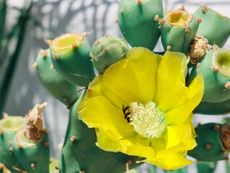 Spineless Prickly Pear Info – Tips For Growing Ellisiana Prickly Pears
Spineless Prickly Pear Info – Tips For Growing Ellisiana Prickly PearsIf you are among the many gardeners who like cactus but don’t like spines, it may be time to consider installing ellisiana cactus in your backyard, better known as spineless prickly pear. Click here for information on growing ellisiana prickly pear.
By Teo Spengler
-
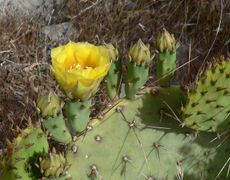 Engelmann Prickly Pear Info – Learn About Growing Cactus Apple Plants
Engelmann Prickly Pear Info – Learn About Growing Cactus Apple PlantsEngelmann prickly pear, also commonly called cactus apple plants, is a wide-ranging species of prickly pear. This is a pretty plant for desert gardens, and it will grow at a moderate rate to fill in large spaces. Learn more about it in this article.
By Mary Ellen Ellis
-
 Cow’s Tongue Plant Care: How To Grow A Prickly Pear Cow’s Tongue
Cow’s Tongue Plant Care: How To Grow A Prickly Pear Cow’s TongueFolks that live in hot climates often utilize plants that are drought tolerant. A great example is a cow’s tongue prickly pear. Besides having a fabulous tongue in cheek name, it is very tolerant of heat and dry conditions, plus it makes a great barrier. Learn more here.
By Amy Grant
-
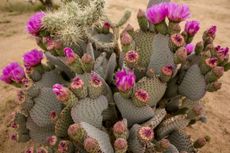 Beavertail Cactus Care – How To Grow A Beavertail Prickly Pear Cactus
Beavertail Cactus Care – How To Grow A Beavertail Prickly Pear CactusBeavertail prickly pear cactus is a clumping, spreading cactus with flat, grayish-green, paddle-like leaves. It glows with brilliant, rose-purple blooms in spring and early summer. Have we piqued your curiosity? Click here for more beavertail prickly pear information.
By Mary H. Dyer
-
 Tulip Prickly Pear Info: Guide To Growing Brown Spined Prickly Pears
Tulip Prickly Pear Info: Guide To Growing Brown Spined Prickly PearsWhat is a tulip prickly pear? This cactus is also known as brown spined prickly pear for its rust to reddish brown spines. If you live in warm, arid regions, learn how to grow brown spined prickly pear and add its unique flowers to your garden. This article will help.
By Bonnie L. Grant
-
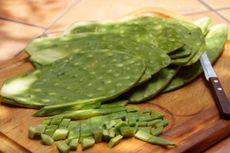 Harvesting Edible Cactus Pads – How To Pick Cactus Pads To Eat
Harvesting Edible Cactus Pads – How To Pick Cactus Pads To EatOpuntia produces several types of edibles. The fruits are delicious in jams and jellies. But can you eat cactus pads? Yes, the broad, succulent pads can be eaten raw or cooked. You just need to know how to pick cactus pads and how to prepare them. This article will help.
By Bonnie L. Grant
-
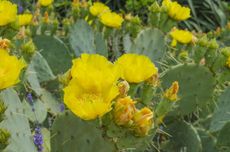 Opuntia Barbary Fig Info: How To Grow A Barbary Fig Plant
Opuntia Barbary Fig Info: How To Grow A Barbary Fig PlantOpuntia ficus-indica is more commonly known as a Barbary fig, a variety of prickly pear cactus. This desert plant has been used for centuries as food, fending, and even dye. Growing Barbary fig plants is both rewarding and useful. Learn more in this article.
By Mary Ellen Ellis